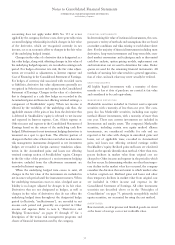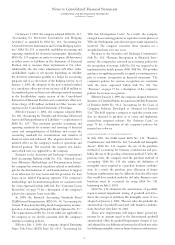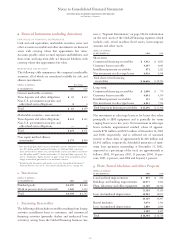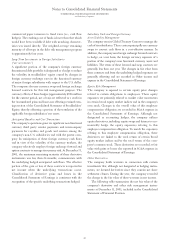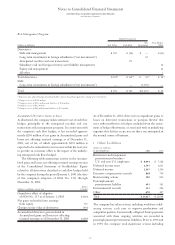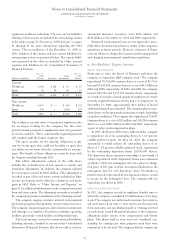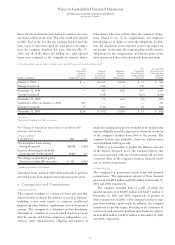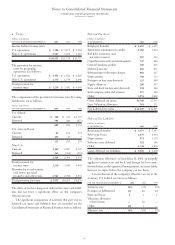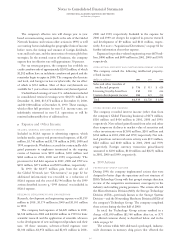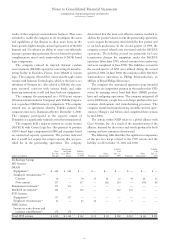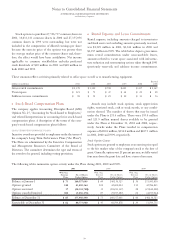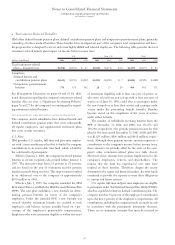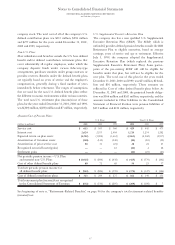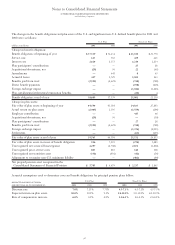IBM 2001 Annual Report Download - page 90
Download and view the complete annual report
Please find page 90 of the 2001 IBM annual report below. You can navigate through the pages in the report by either clicking on the pages listed below, or by using the keyword search tool below to find specific information within the annual report.
Notes to Consolidated Financial Statements
INTERNATIONAL BUSINESS MACHINES CORPORATION
and Subsidiary Companies
88
significant workforce reductions. The non current liabilities
relating to these actions are included in restructuring actions
in the table on page 87. See note q, “1999 Actions,” on pages
91 through 93 for more information regarding the 1999
actions. The reconciliation of the December 31, 2000 to
2001, balances of the current and non current liabilities for
restructuring actions are presented below. The current liabil-
ities presented in the table are included in Other accrued
expenses and liabilities in the Consolidated Statement of
Financial Position.
Dec. 31, Dec. 31,
2000 Other 2001
(dollars in millions) Balance Payments Adjustments Balance
Current:
Workforce $«148 $«128 $««««67 $«««87
Space 91 86 60 65
Total $«239 $«214 $««127 $«152
Non current:
Workforce $«470 $«««— $«««(85) $«385
Space 384 — (180) 204
Total $«854 $«««— $«(265) $«589
The workforce accruals relate to terminated employees who
are no longer working for the company, but who were
granted annual payments to supplement their state pensions
in certain countries. These contractually required payments
will continue until the former employee dies.
The space accruals are for ongoing obligations to pay
rent for vacant space that could not be sublet or space that
was sublet at rates lower than the committed lease arrange-
ment. The length of these obligations varies by lease with
the longest extending through 2012.
The Other Adjustments column in the table above
includes the reclassification of non current to current and
translation adjustments. In addition, the company adjusted
its vacant space accrual by $110 million. This adjustment is
recorded as part of the real estate activity included in Other
income and expense and is offset by a decline in real estate
gains in 2001. Refer to “Other Income and Expense,” on
page 91 for additional information on the company’s net gains
from real estate activity. The adjustment was made as a result of
the company’s periodic reassessment of the remaining accrual.
The company employs extensive internal environmental
protection programs that primarily are preventive in nature.
The company also participates in environmental assessments
and cleanups at a number of locations, including operating
facilities, previously owned facilities and Superfund sites.
The total amounts accrued for environmental liabilities,
including amounts classified as current in the Consolidated
Statement of Financial Position, that do not reflect actual or
anticipated insurance recoveries, were $238 million and
$248 million at December 31, 2001 and 2000, respectively.
Estimated environmental costs are not expected to mate-
rially affect the financial position or results of the company’s
operations in future periods. However, estimates of future
costs are subject to change due to protracted cleanup periods
and changing environmental remediation regulations.
mStockholders’ Equity Activity
STOCK REPURCHASES
From time to time, the Board of Directors authorizes the
company to repurchase IBM common stock. The company
repurchased 50,764,698 common shares at a cost of $5.3 bil-
lion and 61,041,820 common shares at a cost of $6.7 billion in
2001 and 2000, respectively. In 2001 and 2000, the company
issued 1,923,502 and 2,174,594 treasury shares, respectively,
as a result of exercises of stock options by employees of certain
recently acquired businesses and by non-U.S. employees. At
December 31, 2001, approximately $4.6 billion of Board
authorized repurchases remained. The company plans to pur-
chase shares on the open market from time to time, depending
on market conditions. The company also repurchased 314,433
common shares at a cost of $31 million and 249,288 common
shares at a cost of $27 million in 2001 and 2000, respectively,
as part of other stock compensation plans.
In 1995, the Board of Directors authorized the company
to repurchase all of its outstanding Series A 7-1⁄2 percent
callable preferred stock. On May 18, 2001, the company
announced it would redeem all outstanding shares of its
Series A 7-1/2 percent callable preferred stock, represented
by the outstanding depositary shares (10,184,043 shares).
The depositary shares represent ownership of one-fourth of
a share of preferred stock. Depositary shares were redeemed
as of July 3, 2001, the redemption date, for cash at a redemp-
tion price of $25 plus accrued and unpaid dividends to the
redemption date for each depositary share. Dividends on
preferred stock, represented by the depositary shares, ceased
to accrue on the redemption date. The company did not
repurchase any shares in 2000.
EMPLOYEE BENEFITS TRUST
In 1997, the company created an employee benefits trust to
which the company contributed 10 million shares of treasury
stock. The company was authorized to instruct the trustee to
sell such shares from time to time and to use the proceeds
from such sales, and any dividends paid or earnings received
on such stock, toward the partial payment of the company’s
obligations under certain of its compensation and benefit
plans. The shares held in trust were not considered out-
standing for earnings per share purposes until they were
committed to be released. The company did not commit any


